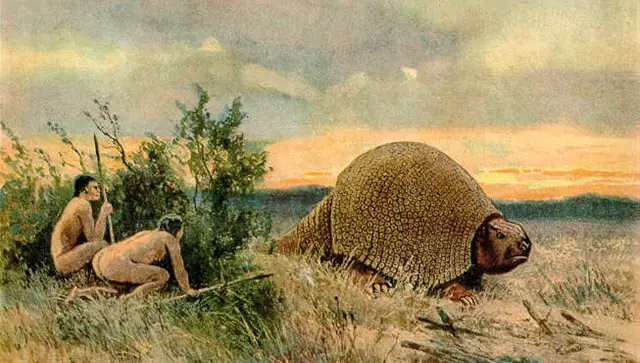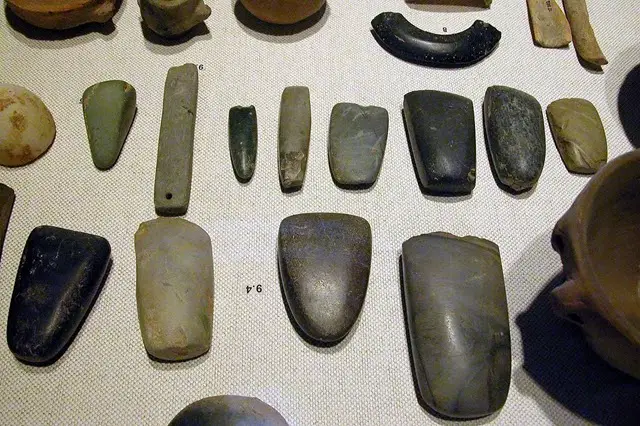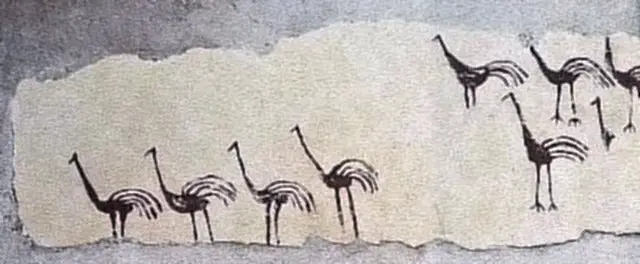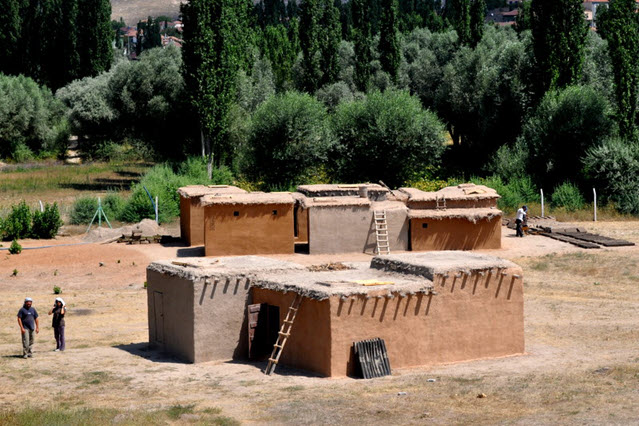
The prehistoric period of human evolution is traced back from 2.5 million years ago to 1200 B.C [1]. It is categorized into the three-age including Stone Age, Bronze, and the Iron age. It is called prehistory because there is no written information about this period.
In the Paleolithic or the Old Stone Age period, early humans lived in caves and huts. They depended upon hunting for their food.
In addition to that, early humans also collected berries, nuts, and fruits to consume. However, the end of this period led to numerous changes including the extinction of large mammals, rising sea levels, climate change, and migration.
On the other hand, in the Neolithic or the New Stone Age period people still used tools made out of stones. The change in climate had turned this period into a warmer period compared to the Old Stone Age.
Apart from climate change, the way of living and means of food also changed during the New Stone Age. People started settling down and learned to grow their crops, rather than search for wild berries and grains. In the New Stone Age people also learned how to train animals to be useful to humans.
The Time Periods
Content

Source: Wikimedia Common
The Stone Age started from 30,000 BCE to 3,000 BCE and ended with the advent of metalworking. It lasted for 3.4 million years.
The Neolithic period was between 8,000 BCE–3,000 BCE, which began 12,000 years ago and the paleolithic period of the stone age was between 30,000 BCE–and 10,000 BCE.
People in the Neolithic Age still used stone tools and weapons, but they were starting to enhance their tools. There’s evidence of initial metallurgy and creating more pottery. A small amount of copper as the earliest evidence for pyrometallurgical copper extraction was found at Çatalhöyük, a neolithic site.[2].
This settlement affords insight into human habitats’ development. It was copper that allowed humans to extend metallurgy techniques. Smelting was discovered accidentally by potters. The first chemical synthesis used by humankind was the working of clay to create pottery in this era.
The Old Stone Age distinguishes the New Stone Age as the period of the agricultural revolution.
The Paleolithic period began with the first evidence of stone tools. This age was 2.5 million years ago, to the end of the last Ice Age in 9,600 BCE. The Palaeolithic is the longest Stone Age period
Humans in the Neolithic and Palaeolithic Periods

Source: Wikimedia Common
In the Neolithic period, ancient humans switched from hunting and gathering to agriculture and food production. They started domesticating animals and cultivating cereal grains.
In the Neolithic period, people also used polished hand axes, and adzes for plowing and tilling the land. They started to settle in the plains.
With the settlement, there was an increase in the size of the population which led to the emergence of numerous diseases including typhoid and tooth cavities.
Apart from that, advancements in farming, tools, home construction, art, pottery, sewing, and weaving took place in this period. Works got divided by gender; women declined as power leaders because when food was scarce, warfare increased and the men gained more prestige.
People also invented the first (but inaccurate) calendars; they used animals (like oxen) to plough. Villages started separating workshops for specialization.
The nomad human settlements transformed into agrarian societies for permanent shelter in the Neolithic period. From this period, there was evidence of early pottery, architecture, construction of megaliths, and sculpture. The Neolithic period also started rock art.[3].
The people in the Palaeolithic age were nomads and depended wholly on their environment for survival. They lived through several ice ages, and invented clothing and fire. They were nomads who believed in animism. They carried small stone statues, worshipped earth-mother goddesses and began burying the dead and providing tools and weapons. They also believed in the afterlife. Palaeolithic humans were taller and lived longer than Neolithic people. Neolithic humans were shorter and had a lower life expectancy.
There were not many humans in the Old Stone Age. They also did not live close together and were spread out. No more than one million humans were living during any time of the Paleolithic Era. Archaeological evidence points that human habitation began in Africa’s continent, and later they migrated to other continents.
Major Discoveries

Source: Wikimedia Common
The Palaeolithic discovered fire and rough stone tools, and the Neolithic discovered agriculture and tools with polished stones[4].
In Palaeolithic times, humans innovated stone tools that resembled broken pieces of rock. They made edged tools by using a stone to knock flakes from the surface of others.
They then used bone or antler hammers to give final touches. The Palaeolithic also discovered Bone Tools that eased their hunting and sewing. Humans then also did cave paintings.
In Neolithic times, farmers produced a surplus of food to share with other people in their community.
Everyone did not have to farm anymore due to surplus. People in the New Stone Age then began to specialize in skills other than farming. They made homes, tools, created jewelry and artwork.
Archaeologists found artefacts like figurines and jewellery, obsidian knives and blades in Catal Hoyuk, a Neolithic city rich with evidence of artwork.
People used tools made from metal towards the end of the Neolithic Era. Copper was used as the first metal for tools. Eventually, it replaced stone, leading to the Copper Age.
Art

Source: Wikimedia Common
The two oldest known art forms, painting and sculpture, were discovered in the Palaeolithic period. Engraved cave paintings were made in this era. These paintings depicted scenes of hunting, handprints and animals.
The earliest known figurative painting ever depicts a bull and is found in the Lubang Jeriji Saleh Cave in Indonesia. Chauvet Cave in France also has paintings of this era. The Chauvet Cave paintings had cave lions, mammoths, and woolly rhinoceroses. The three species make up sixty-five per cent of the paintings’ species and depictions of cave bears.
The rest of the paintings were bison, horses, reindeer, red deer, ibex, aurochs, the extinct Megaloceros deer, musk ox, panthers and an owl. The paintings are notable for depicting actual scenes that reveal the animals’ real behaviours.
Non-representational ornamentation is another discovery of this period. The collection of Nassarius Snail Shells is an example of this art. The sculpture of The Venus figurines’, was also made in the Old Stone Age[5].
Neolithic artists made functional art that they used in their daily lives, such as pottery or terracotta representations of deity that they kept at home.
In this period, greater and larger pieces of megaliths, shrines, tombs, and rock carvings were made. The change in the way people lived also changed the types of art they made.
Wall paintings also started in this era, but they were less durable than cave paintings, and very few survived.
This era is more known for crafts and architecture than painting. Çatalhöyük, a famous Neolithic site in Turkey, has numerous wall paintings. Like Paleolithic paintings, these also depict animals and hunting scenes[6].
Lifestyle

Source: Wikimedia Common
The Paleolithic lived in the mouths of caves, huts and tents made of animal skins. They had a nomadic lifestyle and lived in tribes, and were hunters and gatherers.
The Neolithic built shelters of mud-bricks supported by timber. They had a sedentary lifestyle and farmed in permanent settlements, raised and herded animals. Agriculture got discovered and became a major source of food.
The Paleolithic people moved in search of food, and the Neolithic people moved in search of fertile land and water sources.
Men ruled the Paleolithic society, they had a primitive government and were composed of families. The society had complex governance in the Neolithic era, where the chiefs ruled.
The barter system of trade started in the Neolithic era, but trade was absent in the Paleolithic. People of the Paleolithic age used stone and bones tools, whereas, in the Neolithic era, people started using tools made up of metals(copper and bronze).
The Neolithic era brought the innovation of trade, pottery, weapons, farming, banking, and wheel. The Paleolithic era did not have all these[7].
Tools
In the Neolithic, the stone tools were composite tools, and in the early Palaeolithic, people carved a single stone to make stone tools. The flakes chipped off were discarded, and they used the stones for grubbing roots and hand axes. Then people moved on to core technology, in which they took largely from a stone.
These flakes were used as fine scrapers, and sharp knifelike cutting tools, and attached to sticks as spears. They could make several different types of tools from one stone. The core that was left was discarded.[8].
People went a step further in the Neolithic as they used smaller flakes, set them with pitch or resin into bone or wood holders, to make composite tools. Here, the stones were part of a tool and the saws, bladed axes and knives were hafted onto wooden shafts and bound with leather.
They used the blades to work the wood and set blades into the wood to make crude ploughs. The Neolithic people then used deer antlers with fine flakes to bore through a shard of antler making needles and other fine tools.
They gave arrows a definite shape with a ‘tang’ at the stem to fit accurately onto shaped sticks to make accurate bows and arrows.
The neolithic stone tools were finely worked and crafted but used small sharp flakes set into another medium wood or bone to make sophisticated tools, borers, needles, knives, daggers, scythes, saws, and plows [9].
The fine slivers of flint or Obsidian made excellent cutting tools. They are very sharp, and hygienic, as the surface is completely smooth.
Obsidian does not harbour any virus or bacteria in the slight faults found in Steel blades and can be heated without problems.
However, the big advantage that metal had over stone was that it was less brittle, and could be made into any shape using a mold.
Neolithic stone tools were primitive. The tool users were excellent craftsmen. In the Paleolithic and Neolithic times, tools were made of stone, bone or wood, so there is no major difference in the material used for tools. Both are lithic cultures. Apart from the difference in materials, there were no letters and no writing used in both time epochs, so they both are prehistoric as well.
Palaeolithic tools were basic. They were made of harpoons, axes, lances, choppers and awls.
The first tools were not made by Homo Sapiens but Homo Habilis, about 2,5 million years ago. They also used wood, stone and animal bones.
These tools were wooden weapons, chipped stone and light stone tools which were not sharp. Towards the end of this period, people were more refined and specialized.
Neolithic tools were polished stone tools which were made sharper by grinding. The Neolithic saw the beginning of farming tools to fit the new agricultural lifestyle.
Conclusion
The switch to settling in permanent communities, from a nomadic lifestyle led to impacts on the art forms, lifestyle, climate, burial practices and discoveries in human evolution from the Palaeolithic to Neolithic periods. The Palaeolithic covers the longest period and the Neolithic period is the shortest of the Stone Age.
1. “Paleolithic Technology and Human Evolution – UiO.” http://www.uio.no/studier/emner/hf/iakh/ARK2120/v09/Ambrose%20Palaelithic%20Technology.pdf. Accessed 7 Jan. 2021.
2. “Palaeolithic, Mesolithic, Neolithic, Bronze Age – The Sussex ….” https://sussexpast.co.uk/wp-content/uploads/2011/08/06-09FRCF-for-web.pdf. Accessed 7 Jan. 2021.
3. “Development of Humans from the Paleolithic Era.” https://www.lcps.org/cms/lib/VA01000195/Centricity/Domain/10599/Early%20Humans.pdf. Accessed 7 Jan. 2021.
4. “Lecture 3 Neolithic Revolution and the Discovery of Agriculture.” https://hort.purdue.edu/newcrop/Hort_306/text/lec03.pdf. Accessed 7 Jan. 2021.
5. “cave art and the evolution of the human mind – Core.” https://core.ac.uk/download/pdf/41336956.pdf. Accessed 7 Jan. 2021.
6. “Protecting and Exhibiting Çatalhöyük (PDF).” https://hodder.squarespace.com/s/protecting-and-exhibiting-catalhoyuk.pdf. Accessed 7 Jan. 2021.
7. “The History of Bartering – Bilingue Business Review.” https://www.bilinguebusinessreview.com/the-history-of-bartering.html. Accessed 7 Jan. 2021.
8. “The Paleolithic Age.” http://www.hasdk12.org/cms/lib3/PA01001366/Centricity/Domain/893/The%20Paleolithic%20Age.pdf. Accessed 7 Jan. 2021.
9. “Neolithic transition and lithic technology: The … – quartaer.eu.” http://www.quartaer.eu/pdfs/2015/2015_07_linstaedter.pdf. Accessed 7 Jan. 2021.
